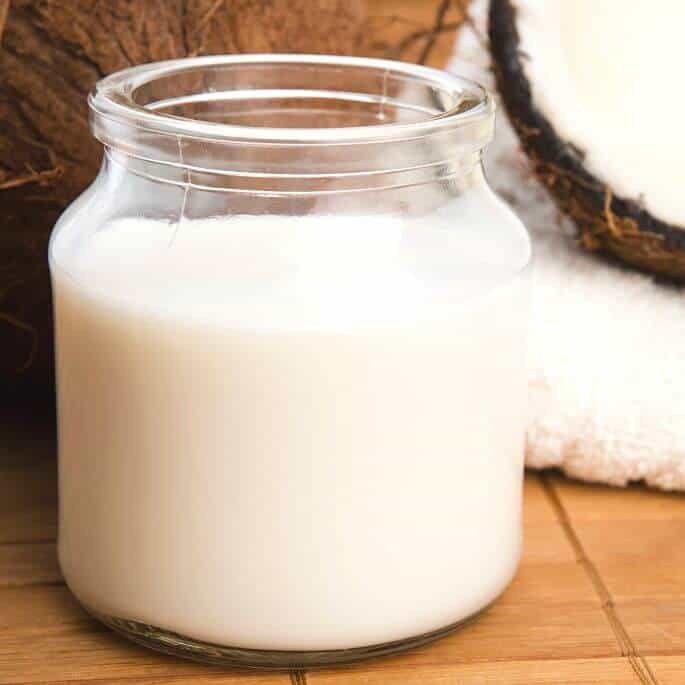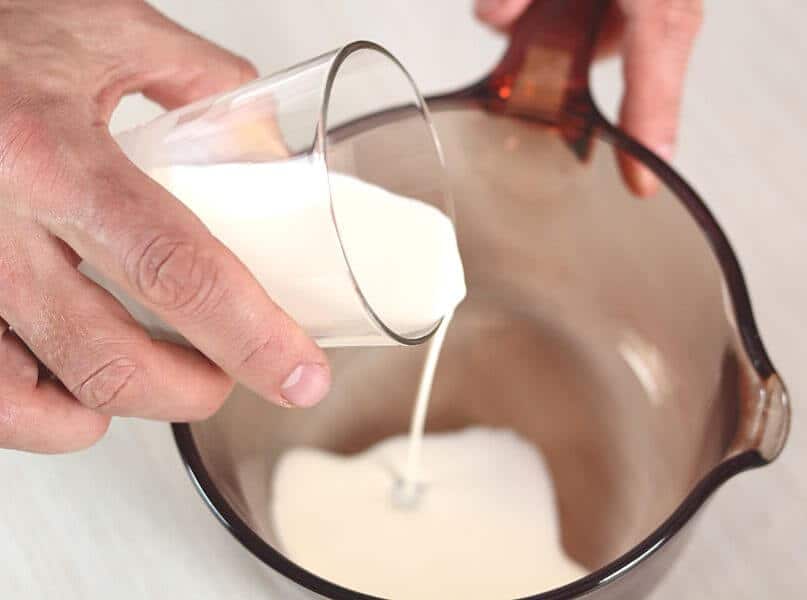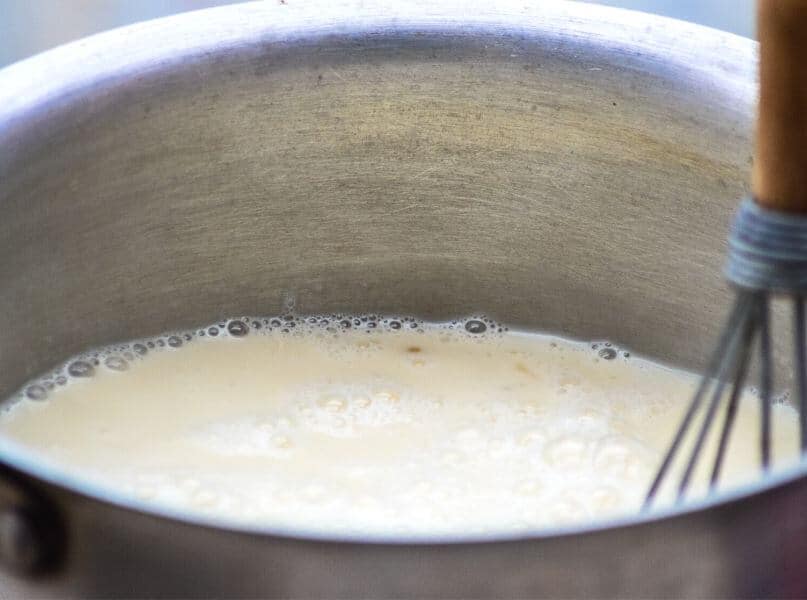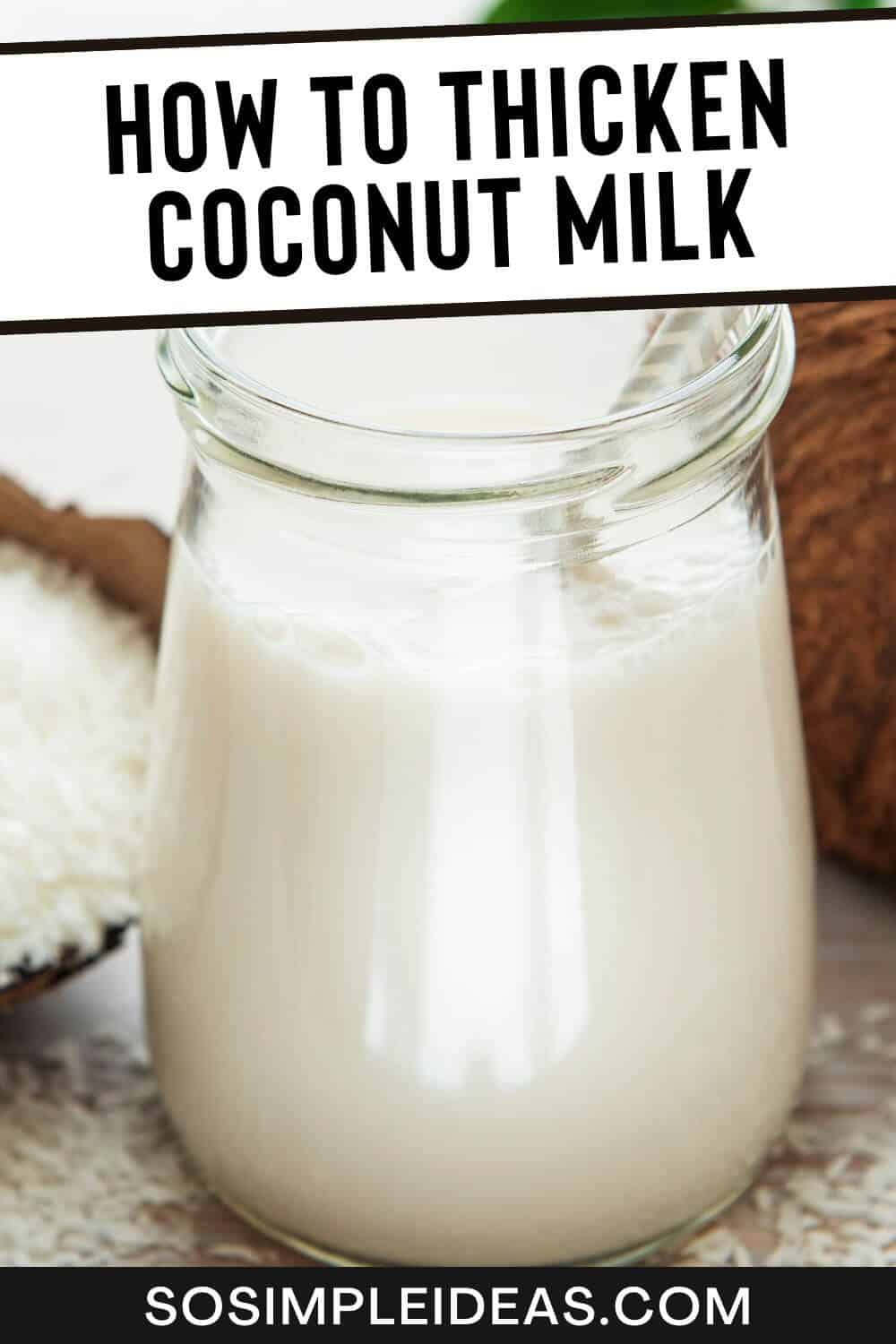So you want to know how to thicken coconut milk but don’t know where to start? This article will walk you through a few different methods that will make the liquid thicker.

Coconut milk is a popular dairy-free and vegan alternative to cow’s milk because of its similar texture and consistency to traditional dairy products. Coconut milk is created by using the grated flesh of young coconuts which is then pressed with water to extract the milk. However, coconut milk can be thinner than traditional milk so you may need to learn how to thicken light coconut milk.
Just like with any type of milk, you can use a variety of methods to thicken coconut milk. Some of them are common and easy to do, while others require special techniques to do the job thoroughly.
If you plan on reducing coconut milk for your favorite recipe or smoothie, then it’s important to know how to thicken coconut milk properly.
Table of Contents
How to extract coconut milk at home
If you want to learn how to thicken light coconut milk, make sure you have some on hand first. While canned and powdered varieties of coconut milk are available, nothing beats the taste of freshly extracted coconut milk. Fortunately, it’s easy to do at home!

With fresh coconut meat, you can do two to three extractions.
- For first extraction: Grate 3 to 4 cups of fresh mature coconut. Add 1/2 cup warm water to the grated coconut meat. Squeeze the mixed water and coconut meat directly over a bowl and strain with a fine mesh sieve.
- For the second extraction: Pour another cup of warm water over the squeezed coconut meat. Continue to squeeze over a bowl and strain.
- Repeat for the steps above for the third extraction.
- Cover and refrigerate for 1 to 2 days or freeze for up to 2 weeks.
How to thicken coconut milk using different methods
Coconut milk is a popular ingredient in a number of recipes due to its creamy, luxurious texture. Coconut milk can improve the consistency of other ingredients, but it’s also popular for using as the base of savory foods.
However, when it comes to cooking and baking, the right consistency is important. While coconut milk is a common ingredient in both sweet and savory recipes, it is often a little too thin.
If you’re hoping to thicken coconut milk without altering its flavor, these simple and satisfying methods are sure to do the trick.
Adding coconut flour
If you are looking for a thickening agent with a coconut flavor, coconut flour is the best choice. Since it is made from coconut, you can add it to coconut milk without diluting the coconut flavor at all. Coconut flour is also perfect for thickening sauces and adding texture to baked goods.

Here are the steps on how to thicken coconut milk with coconut flour:
- Put the coconut milk in a saucepan and set it on medium-low heat.
- Take half a cup of coconut milk out of the pan and mix it with one tablespoon of coconut flour. Mix it well to avoid lumps.
- Pour the mixture back into the original batch of coconut milk, then stir it in and bring to a boil.
Reducing coconut milk
Reducing coconut milk over low heat while it simmers will thicken it naturally, but you may lose some volume in the process. However, you won’t have to sacrifice flavor by doing so! Since you are reducing the coconut milk, it will be intensely flavored.
Follow these steps on how to thicken light coconut milk through reduction:
- Simmer the coconut milk over low heat (without a cover) so that the water evaporates.
- Stir the coconut milk often while it is heating to keep it from curdling. Monitor closely so it doesn’t over-reduce.
- Bring the milk to boil, then simmer until it reaches the thickness you prefer.
Adding potatoes after reduction
Now, you’ve tried making coconut milk reduction, only to discover that the thickened coconut milk is too sweet for your taste. What to do? Fret not! Try out this method on how to thicken coconut milk into cream for a better result:
- Put a pot of water over high heat and add a potato once the water is boiling.
- After boiling the potato, peel it and mash it with a fork until it is a smooth consistency.
- Mix some coconut milk with the mashed potato to make a thick sauce or paste.
- Add the mixture to the reduced coconut milk and stir well. Adding potatoes to the coconut milk will thicken it, give it volume, and absorb some of the sweetness.
Using corn starch
Using cornstarch to thicken soup or dessert is an easy technique that cooks have been using for centuries. You can even use it to thicken coconut milk, although the taste will be slightly altered.
Here are a few easy steps to thicken your coconut milk with cornstarch:
- Dissolve a tablespoon of cornstarch in a bowl with an equal amount of cold water. Keep in mind that 1 tablespoon of cornstarch is needed for every 1 cup of coconut milk.
- Combine the slurry into the coconut milk, then whisk for 1-2 minutes to keep it lump-free.
- Bring to a boil and simmer until it reaches your desired consistency.

Differences between thickening methods
Before you get started, you need to determine whether or not the coconut flavor is important. Be sure to consider how sensitive the recipe is to flavors when choosing a solution on how to thicken coconut milk.
Here are the differences between the thickening methods:
- Adding coconut flour: One of the easiest ways to thicken coconut milk while still preserving the flavor is to use coconut flour.
- Reducing coconut milk: Reducing coconut milk is effective at thickening the milk, but it results in a volume loss and an intensified coconut flavor that is sweeter than the unreduced one.
- Putting potatoes in reduced coconut milk: This method is an addition to the reduction method, but putting potatoes reduces the sweetness of the coconut milk and makes the milk thick enough to form cream.
- Using cornstarch: You can make coconut milk with this method, and it will be thick, but the taste of the coconut will be less pronounced and slightly different.
Which method is the best for thickening coconut milk?
To thicken coconut milk, you can use a number of ways like adding either coconut flour or cornstarch, reducing coconut milk on low heat, or adding a slurry of mashed potatoes. Using coconut flour is the best method because it doesn’t alter the taste of the coconut milk and doesn’t reduce its volume.

How to thicken coconut milk into cream
Coconut cream is a thick, concentrated version of coconut milk. It is a versatile ingredient that can be used in a variety of recipes that call for coconut or heavy cream.
While coconut milk is more common than coconut cream, both are good to have on hand in the kitchen. Coconut cream has the same flavor as coconut milk but you can change its consistency easily.
Don’t worry! Making coconut cream from coconut milk is easy. With these steps you can learn how to thicken coconut milk into cream:
- Simply allow the coconut milk to sit for at least 12 to 16 hours in the refrigerator to help it separate from the coconut water. Up to 24 hours is fine.
- After 12 to 16 hours, the milk will separate into layers — the fat will rise to the top and form a semi-solid layer.
- Skim off the fat that has risen to the top of the milk during the curdling process.
- Whisk until it is smooth, creamy, and homogeneous.
FAQs on how to thicken coconut milk
If you don’t see your question answered below, don’t be afraid to let us know in the comments!
What can I use to thicken coconut cream?
There are a number of ways to thicken coconut milk: You can add either coconut flour or cornstarch, reduce coconut milk on low heat, or add a slurry of mashed potatoes.
Does coconut milk thicken when whisked?
Yes. Scoop out the solid portion of chilled coconut milk and whisk it using an electric beater for about 2 minutes on medium speed, and it will start to thicken.
How do you get coconut milk to set?
Put the can in the refrigerator for 12 to 16 hours so the water and coconut milk solids will have time to separate, allowing the “cream” to rise to the top of the container.
Can you whip up coconut milk?
Yes, you can whip up coconut milk. It’s as simple as refrigerating a can of coconut milk, scooping out the hardened coconut fat, and whipping it just like whipped cream.

Other Articles You May Be Interested In
If you liked this post, you might like these other food-related posts to cook up something delicious at home:

